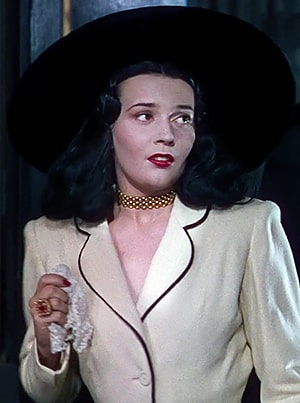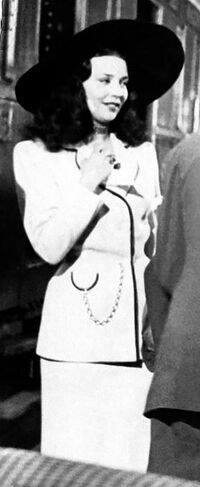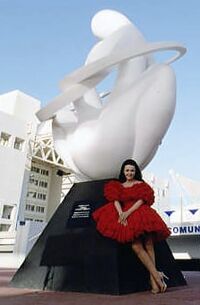Ludmila Canaşvili: Difference between revisions
mNo edit summary |
mNo edit summary |
||
| Line 125: | Line 125: | ||
==Personal life== | ==Personal life== | ||
She was married from 1956 until her death, with no children. She had a {{wpl| | She was married from 1956 until her death, with no children. She and her husband had a {{wpl|threesome}} with [[Anaïs Nin]], which was detailed in her ''Diary''. A close friend of [[Clarissa Rossetti]], she helped her raise her daughter [[Veronica Rossetti]] and was appointed her {{wpl|legal guardian}}; Veronica would later describe Ludmila as "my second mother". | ||
She mainly practiced {{wpl|Georgian mythology|native Karvelebi}} faith combined with [[Concordianism]]. Acquaintances knew her as a very spiritual person, who meditated daily, invoked the Karvelebi gods before a performance, and wore {{wpl|pendant}}s, {{wpl|necklace}}s, and other jewellery emblazoned with the ''{{wpl|borjgali}}''. She found great inspiration in Concordianism's emphasis on [[Concordianism#Movement and dance|dance]] for ritual and symbolism. | She mainly practiced {{wpl|Georgian mythology|native Karvelebi}} faith combined with [[Concordianism]]. Acquaintances knew her as a very spiritual person, who meditated daily, invoked the Karvelebi gods before a performance, and wore {{wpl|pendant}}s, {{wpl|necklace}}s, and other jewellery emblazoned with the ''{{wpl|borjgali}}''. She found great inspiration in Concordianism's emphasis on [[Concordianism#Movement and dance|dance]] for ritual and symbolism. | ||
Revision as of 11:30, 6 June 2022
Ludmila Canaşvili | |
|---|---|
 Ludmila Canaşvili in The Red Shoes | |
| Born | Tamari Mčedlišvili 21 March 1934 |
| Died | 10 October 2014 (aged 80) |
| Occupation |
|
| Years active | 1952–2014 |
Ludmila Canaşvili (Karvelebi: ლიუდმილა ჩანაშვილი; 21 March 1934 – 10 October 2014) was a Gylian ballerina, model, sculptor, actress, painter, choreographer, author, songwriter, and salonnière. Throughout her long career, she was renowned for her multiple talents, refined public image, and exotic beauty. Tomoko Tōsaka praised her as "a woman who spent her life applying her prodigious talents to the improvement of Gylian culture everywhere."
Her name has since entered Gylian slang as a symbol of the polymath ideal, and an example of the individual who "has it all" — multiple talents, personal sophistication, physical attractiveness, and an upstanding reputation.
Early life
She was born Tamari Mčedlišvili (Karvelebi: თამარ მჭედლიშვილი; Gylic transcription: Tamari Mycedlişvili) on 21 March 1934 in Nagykanizsa. She was descended from Karvelebi aristocracy from her father's side, and had some Dellirian ancestry from her mother's side.
Her family fled Ruvelka when the Siduri War broke out. They settled in Alscia, where she began attending school. She started dancing aged 3, and studied with various professors. She recalled in her autobiography:
"At the age of five, I remember reaching out to someone … As this person did not react, I made a gesture of offering. It went far beyond simple movement. That day, I had the revelation of what the gesture could be: a release of feelings. After that, whenever I wanted to express something, I did it by dancing."
Her parents chose to stay in Alscia after the liberation of Ruvelka in 1938, reluctant to disrupt her daughter's friendships by moving back to their homeland. When Alscia voted to join the Free Territories in 1939, they began commuting between Molise and the Free Territories: she attended dance lessons in the former and volunteer classes in the latter.
From childhood, Tamari was known as "Monique" to family and friends. Aware that her Karvelebi name was "a mouthful" for Gylians, she took the stage name "Ludmila Canaşvili" when she began her career. She liked the sound of the name Ludmila, and created the surname "Canaşvili" from the Karvelebi word for "note" (ჩანაწერი čanac̣eri) so that Gylians could pronounce it easily.
Career
Ballet
Ludmila made her stage debut in 1944, as a goblin in a production of A Midsummer Night's Dream, with incidental music by Felix Mendelssohn. Her first ballet performance was Les Sylphides, in 1947.
Her ballet career developed rapidly due to a heavy schedule to entertain troops and civilians during the Liberation War. She co-starred in several ballets with Margot Fontaine, who became her mentor, encouraging both her artistic growth and additional creative pursuits. The two remained close friends for the rest of their lives.
Ludmila developed a distinctive style, synthesising Italian and French ballet with Karvelebi dance. She specialised in comic ballets and ballet blanc.

The end of the war in 1958 allowed her career to thrive. She joined the National Ballet Company of Gylias, and became one of its greatest stars, touring both at home and abroad to critical acclaim. Some of her best-known roles were in Romeo and Juliet (1952), Henri Tomasi's L'Atlantide (1965), Feu aux poudres (1969), La muette de Portici (1982), and Ariadne auf Naxos (1982).
As her career progressed, she increasingly handled her own choreography, and then began to choreograph entire ballets as well as star in them. She believed that ballet had to remain "living and relevant to audiences" rather than "a museum piece", and lent her talents to original, contemporary, and experimental ballets. In a 1967 interview, she said:
"Where people go, we must follow them. If people want psychedelia, we must carve a place for ballet in psychedelia."
She was a passionate champion of Karvelebi and Hayeren composers, using her fame to stage ballets by composers such as Aram Khachaturian.
She had a strong interest in television and cinema adaptations of ballets, commenting: "There is a certain period in which you're at the peak of your physical abilities. That period must be immortalised, and the best medium to do so is film." She starred in televised adaptations of ballet for Gylian Television, and various films.
Beginning in the 1970s, she gradually transitioned away from lead roles, and then towards a behind-the-scenes role as a choreographer. She wrote in her autobiography, "I was happy to take the final bow and retire because I felt I had preserved my work in definitive form, courtesy of the cinema."
Modelling

Ludmila began modelling in her twenties. Her modelling career took off after 1958, aided by the exposure from her success in ballet.
She was photographed by numerous prominent photographers, and obtained notable portraits from Annemarie Beaulieu and Viviane Mayer, among others. Her images appeared in numerous magazines, and were also used by RevCom in public campaigns.
Her modelling work capitalised on her exotic beauty and elegant personality, traits she had refined from her upbringing and ballet career. This allowed her to become a famous representative of socialised luxury during the Golden Revolution.
By contrast, Annemarie's portraits of her sought to capture her "catlike grin and mischievous glee". Annemarie famously described Ludmila as "a little minx occupying a princess' body".
In 1967, she appeared on the cover of The Beaties' Sgt. Pepper's Lonely Hearts Club Band.
Acting

Ludmila began acting in 1956, with a brief role in Une revenant. She appeared in one scene, and later admitted she used the role to "get a foot in the door" in cinema.
Her first lead role was in Amalia Blumenthal's The Red Shoes. The film portrays a ballet company rehearsing and performing a ballet loosely based on the Hans Christian Andersen fairy tale. Production went smoothly, with director and star forming a great rapport. One biographer described their relationship: "Amalia assumed the task of squeezing all of Ludmila's brilliance onto film, and Ludmila did what Amalia asked dutifully."
Released in 1958, The Red Shoes was a significant success. Reviewers praised Ludmila's acting and Amalia's direction, the stark presentation of the rehearsals contrasting dramatically with the impressionistic, lavishly staged ballet sequence that forms its climax. It is considered a classic of Gylian cinema. Ludmila considered it her greatest role, and remarked in her autobiography: "There's not a day where I don't thank Amalia for having granted me immortality."
She went on to star in 16 more films. Some of the more successful ones were musical films in the vein of The Red Shoes, such as cinematic adaptations of The Tales of Hoffmann (1961) and Die Fledermaus (1962). She described these films' ambition to "liberate opera and dance from material constraints and human limitations" by harnessing the potential of cinema, photography, and editing.
She also took straightforward roles that showcased her comedic talents, such as her appearances in A Hard Day's Night (1964) and Magical Mystery Tour (1967), and her work with Megelanese director Luigi Comencini in Six Days a Week (1965).
Throughout her film career, she largely followed the template established by The Red Shoes and A Hard Day's Night: playing "agreeably pampered" aristocrats who were nevertheless charming, sensitive, and helpful to others. Comedies allowed her to exploit the humour of this signature role, transformed into the strait-laced but friendly aristocrat whose classy demeanour humorously contrasts with salacious behaviour and jokes, evocative of Cécile Sorel. This "scandalous princess" image was bolstered by some of her celebrated risqué songs like France Gall's "Les sucettes" and Chantal Beaumont's "Déshabillez-moi".
Art
Ludmila had a lifelong passion for painting and sculpture, and focused on these as she retired from ballet.
She exhibited her works in art galleries from the 1960s until her death. She created numerous oil paintings, charcoal drawings, and gouaches. She adhered to a concept of "total art", of which she said:
"I can only create through movements representing Life, Death, Love — the three dominant themes of dance … I use a synthetic vision of movement, the creative gesture translated into space the same was as the dancer's movement."
Her art style was influenced by surrealism, cubism, and impressionism. Some of her paintings and drawings were used as album covers and art, most notably by The Pixies.
She also conceived and executed several monumental sculptures, including Gylias à Cœur (1991), now located in Mişeyáke's Civic Centre, and Un main amicale (1994), installed on the GNRTS high-speed line to Molise near the border.
Writing
Ludmila was also a writer since her youth, and began to publish her works in the 1970s. These included the novels L'amour au miroir (1973), L'salope (1978), L'femme à l'envers (1986), and Mahra (1999); the short story collections Signes d'vie (1978) and L'ville chante (1983); and several screenplays and poetry collections.
Her writing style matched the easygoing, good-humoured characters she portrayed on screen, and was strongly influenced by Dæse Şyna. Her poetry was similarly marked by playful language and the influence of nonsense verse.
Her autobiography was published in 1996, with an updated edition in 2010.
Other pursuits
Ludmila was a successful salonnière, making her Mişeyáke apartment a popular gathering place for the city's intellectuals and artists. Her salon was part of Mişeyáke's "magic tetragon", located close to Sibylla, Annemarie Beaulieu's studio L'Usine, and the Mişeyáke Metro Mail building.
She was a famous participant in Project Nous, and the 1999 documentary series Nation Building.
Possessed of a "pretty but limited" singing voice, Ludmila did not try to launch a solo musical career. However, she worked occasionally in collaboration with other musicians. She established herself as one of Gylias' leading French-language lyricists under the pseudonym "Monique Stéphanie", writing lyrics for artists like France Gall, Brigitte Nyman, and Chantal Beaumont. She contributed spoken vocals to The Beaties' "Revolution 9", and to Stella Star's Romantique 96.
She was a candidate in the 1967 presidential election, supported by the Centre Group and Union for a New Republic. She finished second, taking 49,8% of the final preference vote against incumbent Eiín Dairyn's 50,2% — the closest a Gylian president came to losing reelection. She was reluctant to involve herself in politics, but accepted appointment to the Senate twice, on 1 June 2001 and 1 March 2002. In the latter term, she notably delivered a tribute to Margot, who had died before she was due to start a new term as Senator.
Ludmila's diverse talents and successful career made her a household name for an elegant polymath; her example made "Ludmila" a popular given name for Gylian children. As arguably Gylias' most famous Karvelebi, she sometimes joked that she conducted her career with the aim of constructing a positive stereotype of Karvelebis.
Alike Demetriou once remarked that Ludmila, with her soothing voice and elegant diction, was one of the few people who could make the consonant-heavy Kartvelian languages sound attractive to Gylian ears. One project Ludmila was proud of was starring in a satirical educational film teaching viewers Karvelebi profanity, thus merging her ethnic pride and "scandalous princess" image. Much to her delight, the film became unexpectedly popular in Gylias and enjoys an enduring cult following. She felt part of this was due to her emphasis on the unexpectedly affectionate or admiring uses of Karvelebi profanity such as shen q'verebs venatsvale, t'rak'iani, mt'q'vneli, dedismt'q'vneli, tesli and uteslesi.
She was a supporter of the Sakarvelbos Damouk’ideblobis Modzraoba, and harnessed her high profile for pro-Zemplen activism during the Zemplen conflict. She lived to see the Ruvelkan victory in the Zemplen War and the formation of the Zemplen Autonomous Region, which she described as "one of the best days of my life".
Death
She died on 10 October 2014 in Mişeyáke, after a long illness. She was praised in The Republic's obituary as "a great artist who showed exceptional creative vitality in all the arts which she practised with talent."
Personal life
She was married from 1956 until her death, with no children. She and her husband had a threesome with Anaïs Nin, which was detailed in her Diary. A close friend of Clarissa Rossetti, she helped her raise her daughter Veronica Rossetti and was appointed her legal guardian; Veronica would later describe Ludmila as "my second mother".
She mainly practiced native Karvelebi faith combined with Concordianism. Acquaintances knew her as a very spiritual person, who meditated daily, invoked the Karvelebi gods before a performance, and wore pendants, necklaces, and other jewellery emblazoned with the borjgali. She found great inspiration in Concordianism's emphasis on dance for ritual and symbolism.
Throughout her career, she strove to maintain the primacy of her Karvelebi identity. She insisted that all her writings be published first in Karvelebi and then translated into French and other languages. She was a supporter of the francité movement, and often made playful jabs at the character and popularity of English, dismissing it as "inferior" to French. Interviewed by L'Petit Écho in 2004, she quipped: "I'm 70 years old... and, thank Ghmerti, I still can't speak English!".

